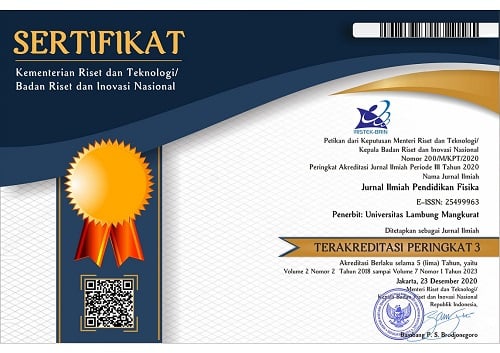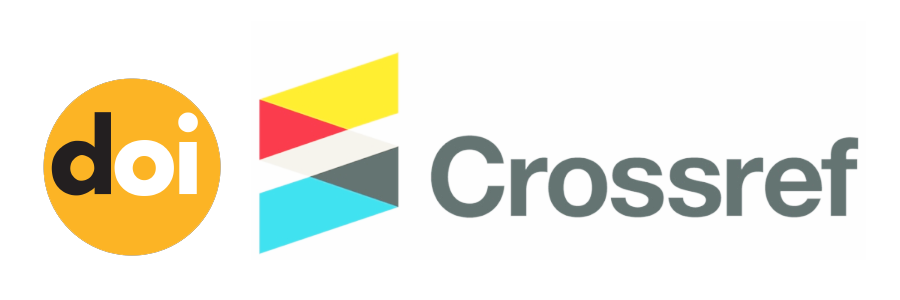Students’ Response to the Basic Physics Textbook Integrated with Faith, Piety, and Local Wisdom
Abstract
This research was conducted due to the unavailability of textbook in lecture of Basic Physics 1. The aim of this research was to describe the response of students to basic physics textbook that contained the value of faith and piety and integrated with South Borneo local wisdom in the direct instruction model setting that has been developed. The method of this research was descriptive analytic. The subjects of the try out were 17 first-semester students of the Physics Education Department Faculty of Education and Teacher Training UIN Antasari Banjarmasin who participated in the Basic Physics 1 lecture in the 2018/2019 academic year. Data was obtained through student response questionnaires. Data were analyzed quantitatively and qualitatively. The results showed that students' response to the content, appearance, and language of textbook were in the good criteria with an average score of 4.31 and 100% of students stated that they were interested in using the textbook. It could be concluded that the basic physics textbook integrated with faith, piety, and local wisdom in direct instruction model setting is feasible to use in the Basic Physics 1 lecture.
Keywords
Full Text:
PDFReferences
Akbar, S. (2016). Instrumen perangkat pembelajaran. Bandung: PT Rosdakarya.
Akin, U. S., & Arslantekin, B. A. (2017). Correlated-features sequence and cognitive strategy education based on direct instruction model in math skills of students with special needs. The Online Journal of New Horizons in Education, 7(1), 37–46.
Anwar, S., & Elfiah, R. (2019). Science and religious integration (implications for the development at UIN Raden Intan Lampung). Journal of Physics: IOP Conference Series, 1155 01209, 1–9.
Blašková, M. (2014). Influencing academic motivation, responsibility and creativity. Procedia - Social and Behavioral Sciences, 159, 415–425.
BSNP. (2014). Instrumen Penilaian buku teks pelajaran fisika Sekolah Menengah Atas/Madrasah Aliyah. Jakarta: Badan Standar Nasional Pendidikan.
Cahyono, B., Tsani, D. F., & Rahma, A. (2018). Pengembangan buku saku matematika berbasis karakter pada materi trigonometri. Jurnal Phenomenon, 08(2), 185–199.
Colakoglu, O. M., & Akdemir, O. (2010). Motivational measure of the instruction compared: Instruction based on the ARCS motivation theory v.s. traditional instruction in blended courses. Turkish Online Journal of Distance Education, 11(2), 73–89.
Derya, K., & Eryilmaz, A. (2010). Identifying pre-service physics teachers’ misconceptions with three-tier tests. In . GIREP-ICPE-MPTL Conference: Teaching and Learning Physics today: Challenges (pp. 1–8).
Ewing, B. (2011). Direct instruction in mathematics: issues for schools with high indigenous enrolments : a literature review. Australian Journal of Teacher Education, 36(5), 64–91.
Georgiou, H., & Sharma, M. D. (2012). University students’ understanding of thermal physics in everyday contexts. International Journal of Science and Mathematics Education, 10(5), 1119–1142.
Harsono, Y. M. (2007). Developing learning materials for specific purposes. TEFLIN Journal, 18(2), 169–179.
Hartini, S., Firdausi, S., Misbah, & Sulaeman, N. F. (2018). The development of physics teaching materials based on local wisdom to train saraba kawa characters. Jurnal Pendidikan IPA Indonesia, 7(2), 130–137.
Hartini, S., Isnanda, M. F., Wati, M., Misbah, M., An’nur, S., & Mahtari, S. (2018). Developing a physics module based on the local wisdom of Hulu Sungai Tengah regency to train the murakata character. Journal of Physics: IOP Conference Series, 1088, 1–6.
Hasan, S. H., Wahab, A. A., Hamka, Kurniawan, Anas, Z., & Nurlaili, L. (2010). Pengembangan pendidikan budaya dan karakter bangsa. Jakarta: Kementerian Pendidikan Nasional: Badan Penelitian dan Pengembangan Pusat Kurikulum.
Jamal, M. A. (2009). Pengembangan teknik pemodelan fisika melalui pengajaran langsung pada perkuliahan fisika dasar. Universitas Negeri Surabaya.
Jasien, P. G., & Oberem, G. E. (2002). Understanding of elementary concepts in heat and temperature among college students and K-12 teachers. Journal of Chemical Education, 79(7), 889–895.
Kang, H., Scharmann, L., Kang, S., & Noh, T. (2010). Cognitive conflict and situational interest as factors influencing conceptual change. International Journal of Environmental & Science Education, 5(4), 383–405.
Khalil, M. K., & Elkhider, I. A. (2016). Applying learning theories and instructional design models for effective instruction. Advances in Physiology Education, 40, 147–156.
Kurniawati, A. A., Wahyuni, S., & Putra, P. D. A. (2017). Utilizing of comic and Jember’s local wisdom as integrated science learning materials. International Journal of Social Science and Humanity, 7(1), 47–50.
Latifah, S., & Ratnasari. (2016). Pengembangan Modul IPA Terpadu Terintegrasi Ayat-Ayat Al- Qur ’ an pada Materi Tata Surya. Jurnal Penelitian Pembelajaran Fisika, 7(20), 25–33.
Mastuang. (2015). Implementasi pembelajaran menggunakan model pengajaran langsung untuk meningkatkan hasil belajar mahasiswa. Jurnal Sains Dan Pendidikan Fisika, 11(2), 113–119.
Mastuang, M., Misbah, M., Yahya, A., & Mahtari, S. (2019). Developing the physics module containing Quranic verses to train the local wisdom character. Journal of Physics: IOP Conference Series, 1171 01201, 1–7.
Meliono, I. (2011). Understanding the nusantara thought and local wisdom as an aspect of the indonesian education. TAWARIKH: International Journal for Historical Studies, 2(2), 221–234.
Ogunleye, A. O. (2009). Teachers’ and students' perceptions of students’ problem-solving difficulties in physics: implications for remediation. Journal of College Teaching and Learning, 6(7), 85–90.
Palmer, D. H. (2009). Student interest generated during an inquiry skills lesson. Journal of Research in Science Teaching, 46(2), 147–165.
Pornpimon, C., Wallapha, A., & Prayuth, C. (2014). Strategy Challenges the local wisdom applications sustainability in schools. Procedia - Social and Behavioral Sciences, 112, 626–634.
Purnama, D., & Surya, E. (2017). Development the module of mathematics statistics 1 by using the model of dick and carey design. International Journal of Sciences: Basic Ad Applied Research (IJSBAR), 34(1), 237–246.
Riduwan. (2015). Skala pengukuran variabel-variabel penelitian. Bandung: Alfabeta.
Salmiza, S. (2011). The level of B.Sc.Ed students’ conceptual understanding of newtonian physics. International Journal of Academic Research in Business and Social Sciences, 1(3), 249–256.
Stockard, J., Wood, T. W., Coughlin, C., & Khoury, C. R. (2018). The effectiveness of direct instruction curricula: a meta-analysis of a half century of research. Review of Educational Research, 20(10), 1–29.
Sugiyono. (2013). Metode penelitian pendidikan: pendekatan kuantitatif, kualitatif, dan R & D. Bandung: Alfabeta.
Susilawati, Fikriyah, F., & Saefudin, A. (2016). Science education based on cirebon local culinary food. UMRAN -International Journal of Islamic and Civilizational Studies, 3(3–1), 42–49.
Syring, M., Kleinknecht, M., Bohl, T., Kuntze, S., Rehm, M., & Schneider, J. (2015). How problem-based or direct instructional case-based learning environments influence secondary school pre-service teachers’ cognitive load, motivation and emotions: A quasi-experimental intervention study in teacher education. Journal of Education and Human Development, 4(4), 115–129.
Tanujaya, B., Prahmana, R. C. I., & Mumu, J. (2017). Mathematics instruction, problems, challenges and opportunities: a case study in Manokwari Regency, Indonesia. World Transactions on Engineering and Technology Education, 15(3), 287–291.
Termtachatipongsa, P. (2014). Instructional context, motivational beliefs, attitude and strategies in teaching genetics for conceptual change. Procedia-Social and Behavioral Sciences, 116, 2023–2029.
Toharudin, U., & Kurniawan, I. S. (2017). Values of local wisdom: a potential to develop an assessment and remedial. International Journal of Evaluation and Research in Education (IJERE), 6(1), 71–78.
Walsh, L. N., Howard, R. G., & Bowe, B. (2007). Phenomenographic study of students’ problem solving approaches in physics. Physical Review Special Topics-Physics Education Research, 3(2), 1–12.
Wenno, H. (2014). Direct instruction model to increase physical science competence of students as one form of classroom assesment. International Journal of Evaluation and Research in Education (IJERE), 3(3), 169–174.
Zainuddin, Afnizar, H. A., Mastuang, & Misbah. (2018). Developing a teaching material oriented to science and technology and local wisdom in wetland environment. Advances in Social Science, Education and Humanities Research, 274, 323–325.
DOI: https://doi.org/10.20527/jipf.v4i1.1775
Refbacks
- There are currently no refbacks.
Indexed by: Jurnal Ilmiah Pendidikan Fisika is licensed under a creative commons attribution-share alike 4.0 international license
Statistics Counter |
















